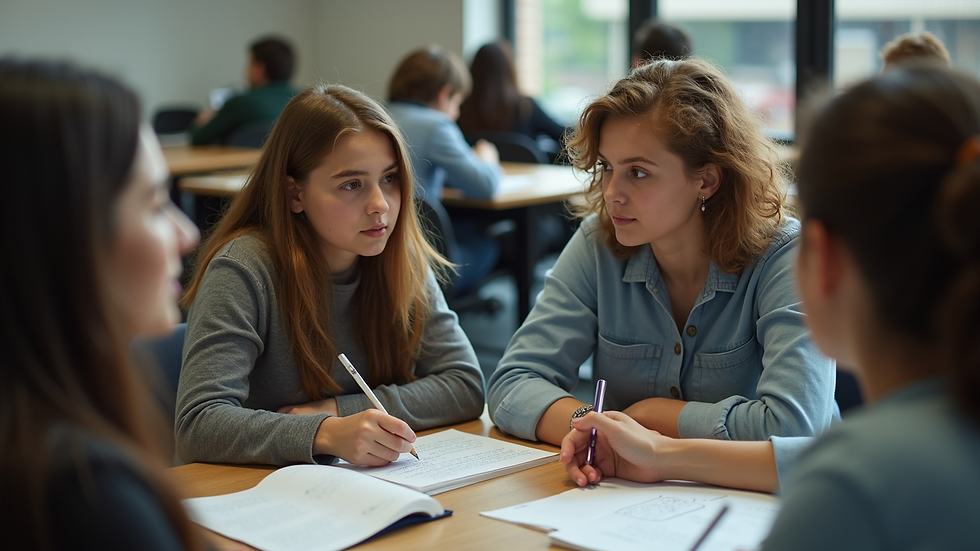How to Create an Engaging Classroom Experience at Master Universal School in Pennagaram
- Web Hive Solution

- Mar 22
- 4 min read
Updated: May 3
Creating an engaging classroom experience is vital for encouraging a love of learning and keeping students interested. At Master Universal School in Pennagaram, you can build a lively and supportive environment that caters to the diverse needs of young learners. This post provides insights and strategies to transform your classroom into an exciting learning space.
Understanding Your Students
To create an engaging classroom, begin by recognizing the unique personalities and learning styles of your students. Each child has their own strengths and interests, and understanding these differences is crucial for effective teaching.
Conduct informal assessments, such as quick surveys or one-on-one chats, to gather insights about your students’ preferences. For instance, you might discover that 70% of your class enjoys hands-on activities or that many are visual learners. By integrating activities that cater to various learning styles—like using visuals for concepts or engaging students in group discussions—you can help boost their confidence and motivation.
By deepening your understanding of your students, you will create a stronger connection, making lessons more relevant and impactful.
Designing an Inspiring Classroom Space
The physical environment of your classroom significantly influences the learning experience. Use bright colors, stimulating décor, and flexible seating to foster a creative atmosphere. For example, incorporating a colorful reading corner with cushions and books can encourage students to explore literature.
Consider implementing learning stations that support different activities, such as group projects, hands-on experiments, or art showcases. Arrange desks in clusters or circles to promote collaboration instead of traditional rows; this can encourage students to talk and work together more easily.

Incorporating Interactive Learning
Incorporating interactive learning strategies is crucial for engaging students. Hands-on activities help turn abstract concepts into practical experiences. Here are a few effective methods:
Group Projects: Assign collaborative projects that foster teamwork and creativity. For instance, students can work together to create a presentation on a historical event, which helps them learn to communicate and solve problems collaboratively.
Interactive Technology: Utilize educational apps and tools to enhance your lessons. For example, using tablets for quizzes can increase participation; studies show that technology integration can boost student engagement by up to 80%.
Gamification: Introduce game-like elements into lessons. Whether through trivia games or skill challenges, adding competition can make learning exciting. As an example, a math competition where students solve problems to earn points can motivate even the most reluctant learners.
These interactive methods not only deepen students' understanding of the subjects but also nurture a positive classroom culture.
Building Strong Teacher-Student Relationships
Establishing strong connections with your students is essential for creating an engaging classroom environment. When students feel valued, they are more likely to participate and take risks.
Invest time in learning about your students’ interests outside of academics. For instance, if a student loves video games, you can incorporate calculations related to game scores into math lessons. This relevance connects learning to their passions.
Practice patience and empathy to understand the unique challenges each student faces. By creating a safe space where students feel comfortable to express themselves, you promote a culture of collaboration and growth.

Implementing a Positive Classroom Management System
Effective classroom management is key to creating a productive learning environment. Clear rules and expectations should be established from the beginning to promote respect and responsibility. Research indicates that classrooms with clear guidelines have a 30% increase in student compliance.
Encourage positive behavior through recognition and rewards, which fosters an uplifting atmosphere. Regular classroom meetings can also create a space for students to voice their concerns and feel heard. This collaborative approach not only addresses issues but also empowers students to take ownership of their behavior and learning.
Encouraging Parental Involvement
Parental involvement is crucial for maintaining an engaging classroom. Building strong partnerships with parents through consistent communication can enhance the learning environment.
Invite parents to participate in classroom activities, such as guest reading sessions or workshops. Sharing regular updates about their child's progress can motivate parents to engage in their education actively. A study found that students whose parents are involved in their education score 20% higher on standardized tests.
By fostering a strong home-school connection, parents become vital partners in their child's learning journey and reinforce concepts taught in class.
Integrating Creativity into the Curriculum
Creativity can significantly boost student engagement. Designing lessons that allow for creative expression makes learning come alive. For example, art projects can be integrated into science lessons, such as creating posters about ecosystems.
Empowering students to express their ideas encourages innovative thinking and keeps enthusiasm for learning alive. Allow students to share their passions through projects or presentations, which not only enriches their understanding but also celebrates their unique talents.

Final Thoughts
Creating an engaging classroom experience at Master Universal School in Pennagaram is essential for nurturing a lifelong love of learning in students. By understanding your students, designing an inspiring physical space, and implementing interactive learning strategies, you can cultivate an environment that motivates and supports their growth.
Remember to build relationships with both students and parents to foster a community around education. Innovative and creative teaching approaches can enhance academic performance while enriching the overall school experience. Investing time and effort into an engaging classroom will set your students on a path toward success and fulfillment in their educational journey.








Comments